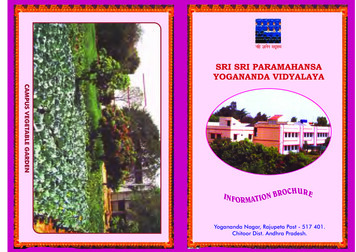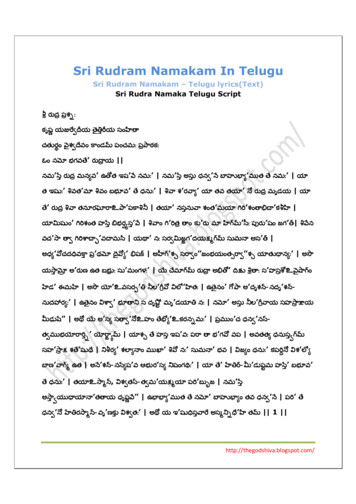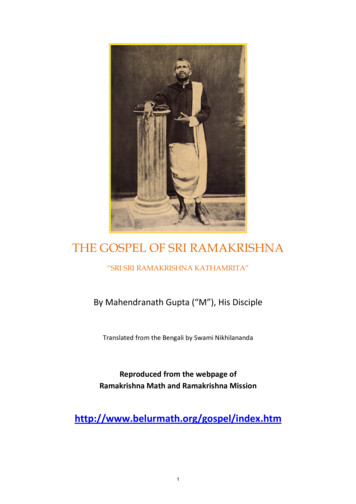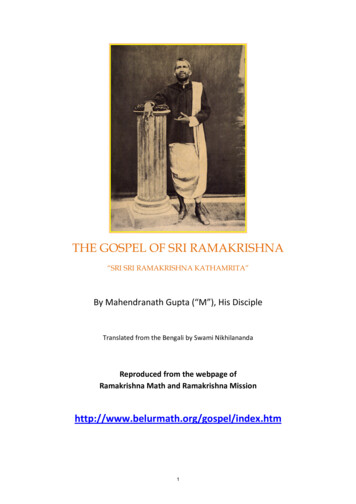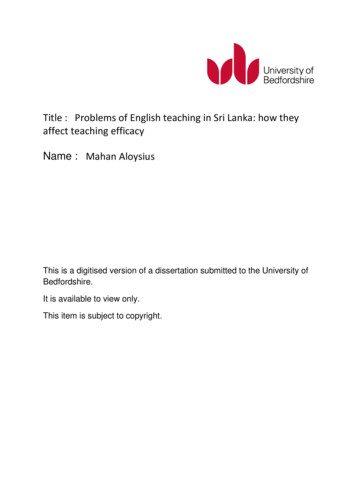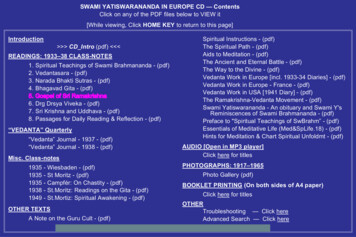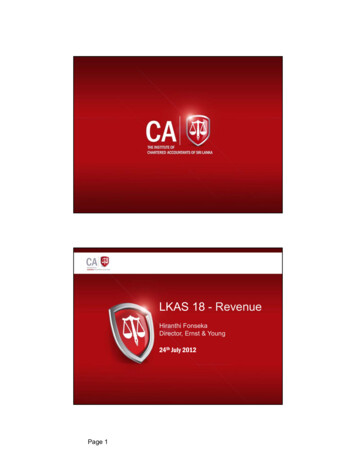
Transcription
LKAS 18 - RevenueHiranthi FonsekaDirector, Ernst & Young24th Julyy 2012Page 1
Accounting for substance rementsPrincipleof theStandardAccounting for theTransactionEx: CIF withInstallationPage 3LKAS 18 - RevenuePage 4Page 2
What is Revenue? Revenue is the gross inflow of economic benefits duringthe period arising in the course of the ordinary activities ofan entity when those inflows result in increases in equity,equityother than increases relating to contributions from equityparticipants. LKAS 18 shall be applied to the sale of goodsthe rendering of services, andthe use by others of the entity’s assets yielding interest, royaltiesand dividendsPage 5Scope exclusions The standard does not deal with revenue arising from;Lease agreementsDi id d arisingDividendsi i ffrom iinvestmentstt whichhi h are accountedt d ffor underdthe equity methodInsurance contracts within the scope of SLFRS 4Changes in the fair value of financial assets and financialliabilities, or their disposalChanges in the value of other current assetsInitial recognitiongand changesg in the fair value of biologicalgassets related to agricultural activityInitial recognition of agricultural produceThe extraction of mineral oresConstruction contractsPage 6Page 3Presentation title
Scoping of real estate sales –IFRIC 15Two forms of contract are seen in practice: The buyer is able to specify the major structural elements of the designof the real estate before construction begins and/or specify majorstructuralt t l changeshonce constructiont ti isi iin progress. The buyer may only have limited ability to influence the design of thereal estate, Ex: to select a design from a range of options specified bythe entity, or to specify only minor variations to the basic design such astypes of flooring or kitchen fittings.Will the transactions be scoped under LKAS 18 or LKAS 11?Definition of a construction contract is:'a contract specifically negotiated for the construction of an asset or acombination of assets.’Page 7Presentation titlePrinciple agency relationshipRevenue - the gross inflows of economic benefitsreceived/receivable by the entity on its own account.Practical Scenarios Taxes (NBT) Ticketing agencies Hotels – Spas Travel Agents Distributing Channels Shipping – Freight forwarding/cargo etc.Page 8Page 4Presentation title
Indicators of acting as principleEntity is primarily responsible forproviding goods and services tocustomers Ex: Hotel Spa Entity has inventory risk Ex:Shipping Entityy has latitude in establishinggprices Ex: Shipping/Ticketing Entity has customers credit riskPage 9Presentation titleMeasurementPage 5
Measurement of revenueRevenue shall be measured at the fair value of theconsideration received or receivable. The standard defines fair value as the amount for which an assetcould be exchanged, or a liability settled, between knowledgeable,willing parties in an arm’s length transaction.Page 11Presentation titleExample:When inflow of cash or cash equivalents is deferred, the fairvalue of the consideration may be less than the nominalamount of cash received or receivable.Ex: Interest free credit to the buyer.Page 12Page 6Presentation title
Example – Cont;The difference between the FV and the nominal amount ofthe consideration is recognised as interest revenue. (LKAS39)FV of theSaleFinancingElementRecognised whengoods are soldPage 13NominalValueRecognised overthe financing periodPresentation titleIdentification of the TransactionLKAS 18 requires transactions to be combined or segmentedwhen this is necessary in order to reflect the substance of thearrangements.Combining a series of transactions for thepurpose of revenue recognition is requiredwhen two or more transactions are linked insuch a way that the commercial effect cannotbe understood without reference to the seriesof transactions as a whole.Ex: Bundled offers in TelecommunicationIndustryPage 14Page 7Presentation title
Identification of the Transactioncont .Revenue recognition criteria must be applied toseparately identifiable components of a singletransaction when the components are essentiallyunrelated.Ex: When product includes subsequent servicingRewards pointsPage 15Presentation titleIFRIC 13: Customer LoyaltyProgrammesAn entity’s obligation to provide free or discounted goods orservices (‘awards’) in the future under a customer loyaltyprogramme should be recognized and measured by revenuedeferral. The award credits are accounted for as a separatelyidentifiable component of the sales transaction The consideration allocated to the award credits shall bemeasured by reference to their fair value.Page 16Page 8Presentation title
How do you measure FV ofloyalty schemes?IFIRC does not specify a quantitative technique.There are two interpretations of measurement of FVFV.a) equal to their fair value(irrespective of the fair valuesof the other elements); or(b) a proportion of the totalconsideration based on the fairvalue of the award creditsrelative to the fair values of theother elements of the sale.Page 17Presentation titleExample 1A retailer sells goods to a customer and issues 100 award credits for atotal consideration of Rs1,000. The retailer determines that the fairvalue of the 100 award credits is Rs 50.Applying the two approaches above, the retailer could allocate therevenue as follows:a) equal to the fair value of the credits:Revenue allocated to the award credits (deferred)Revenue allocated to the goods (recognised in P&L)b) based on the relative fair values:Revenue allocated to the award credits (deferred)(1,000 x 50)1,050Revenue allocated to the goods (recognised in P&L)(1,000 x 1,000)1,050Page 18Page 9Presentation titleRs 50Rs 950Rs 1,000Rs 48Rs 952Rs 1,000
Example 2An entity issues 5,000 award credits. It expects 80% of these award credits(i.e., 4,000) to be redeemed, and estimates the fair value of the 5,000 awardcredits to be Rs. 2,000 and defers revenue of this amount.By the end of year one, 1,500 award credits have been redeemed.The revenue recognised is:1,500 * 2,000 Rs. 7504,000By the end of year two, a further 800 award credits have been redeemed,bringing the total award credits redeemed to date to 2,300. Management nowexpects 85% of the issued award credits (i.e.,(i e 44,250250 award credits) to beredeemed. Revenue recognised for the year is:2300 *2000 – 750 Rs. 3324,250Page 19Presentation titleSale of GoodsPage 10
Sale of goodsRevenue from the sale of goods shall be recognized, when all thefollowing conditions have been satisfied.The significant risks and rewards of ownership of the goodshave been transferred to the buyer The seller retains neither continuing managerial involvement tothe degree usually associated with ownership nor effectivecontrol over the goods soldEx: Sale of Land The amount of revenue can be measured reliably It is probable that economic benefits associated with thetransaction will flow to the entity and The costs incurred or to be incurred can be measured reliablyPage 21Presentation titleThe risks and rewards of ownership Examples where the risks and rewards are retained th entitythetit retainst i an obligationbli ti ffor unsatisfactoryti f tperformancefnot covered by normal warranty provisionsthe receipt of the revenue from a particular sale is contingenton the derivation of revenue by the buyer from its sale of thegoodsthe goods are shipped subject to installation and theinstallation is a significant part of the contract which has notyett beenbcompletedl t dbby ththe entity,titthe buyer has the right to rescind the purchase for a reasonspecified in the sales contract and the entity is uncertainabout the probability of returnPage 22Page 11Presentation title
Example: Accounting PolicyAtlas Copco AB (2008)Notes to the Consolidated Financial Statements [extract]Significant accounting principles [extract]Revenue recognition [extract]Goods sold [extract]Revenue from sale of goods is recognized when the significant risks andrewards of ownership have been transferred to the buyer, which in mostcases occurs in connection with delivery. When the product requiresinstallation and installation is a significant part of the contractcontract,revenue is recognized when the installation is completed.Page 23Presentation titleExample: Sale of GoodsEntity Vstart sells goods to Entity Realstart.At Realstart’s requestqthe deliveryy of ggoods isdelayed.However, Vstart has fulfilled all of itsresponsibilities as the sellers: the goods areidentified and ready for delivery to Realstart.Realstart has specifically acknowledged thedeferred delivery instruction and the usualpayment terms apply.Page 24Page 12Presentation title
Revenue from ServicesRendering of ServicesWhen the outcome of a transaction involving the rendering of servicescan be estimated reliably, revenue associated with the transactionshall be recognised by reference to the stage of completion of thetransaction at the end of the reporting period.periodThe outcome of a transaction can be estimated reliably when all the conditions beloware satisfied:1. The amount of revenue can be measured reliably2.It is probable that economic benefits will flow to the entity3.The stage of completion can be measured reliably4.The costs incurred and the costs to complete the transaction can be measuredreliablyEx: Installation fees are recognised as revenue by reference to the stage ofcompletion of the installation.Page 26Page 13Presentation title
Determining stage of completion Surveys of work performedServices performed to date, as a percentage of total services tobe performed, orThe proportion that costs incurred to date bear to the estimatedtotal costs of the transaction For this purpose, only costs that reflect services performed to dateare included in costs incurred to date, and only costs that reflectservices performed or to be performed are included in the estimatedtotal costs of the transactionPage 27Important For practical purposes, when Services are performed by an indeterminatenumber of acts over a specified period, the standard states that revenueshouldh ld bbe recognisedi d on a straightt i ht lineli basisb i over theth specifiedifi d periodi d unlesslthere is evidence that some other method better represents the stage ofcompletion. Ex: Outsourcing arrangements, helpdesk support, etc. However, when a specific act is much more significant than any other acts,the standard requires that the recognition of revenue be postponed until thesignificant act is executedexecuted.Page 28Page 14
Interest, royalties and dividendsInterest, royalties and dividends Provided it is probable that the economic benefits willflow to the entity, and the amount of revenue can bemeasured reliablyreliably, revenue is recognised as follows Interest: using an effective interest method as set out in LKAS 39 Royalties: on an accrual basis in accordance with the substanceof the relevant agreement, and Dividends: when the shareholder’s right to receive payment isestablishedPage 30Page 15
DisclosuresDisclosure requirements The amount of each significant category of revenuerecognisedi ddduringi ththe period,i d iincludingl di revenue arisingi ifrom: the sale of goodsthe rendering of servicesinterestroyalties, andDividendsThe amount of revenue arising from exchanges of goods or servicesincluded in each significant category of revenuePage 32Page 16
Disclosure requirements The accounting policies adopted for the recognition ofrevenue, includingi l di theth methodsth d adoptedd t d tto ddeterminetithe stage of completion of transactions involving therendering of servicesPage 33Example: Nokia Corporation 2008Page 34Page 17
More Interpretations!Scoping of real estate sales –IFRIC 15 This Interpretation applies to the accounting for revenue andassociated expenses by entities that undertake the construction ofreal estate directly or through subcontractorssubcontractors.Agreements in the scope of this Interpretation are agreements for theconstruction of real estate. In addition to the construction of realestate, such agreements may include the delivery of other goods orservices. IssuesThe Interpretation addresses two issues: (a) Is the agreement within the scopeof IAS 11 or IAS 18? (b) When should revenue from theconstruction of real estate berecognised?Page 36Page 18
IFRIC 15 - Agreements for theConstruction of Real EstateReal Estate Contracts(a) Entity does not have to acquire and supply constructionmaterial(b) Entity has to provide services and construction materials todeliver the real estate to the buyerAgreement is aConstructioncontractScope ofLKAS 11Scope of LKAS 18Rendering ofservices(a)Sale of goods(b)Revenue recognitionby reference to thestage of completionin accordance withLKAS 11Page 37Revenue recognition under IFRIC 15Renderingof services Revenue recognitionbased on reference tostage of completion Control and the significant risks and rewards ofownershipSale ofgoodsdPage 38Page 19 Of the work in progress is transferred in its current stateas construction progresses. Revenue recognised byreference to the stage of completion using the percentageof completionpmethod Of the real estate is transferred in its entirety at a singletime (eg at completion, upon or after delivery). Revenuerecognised only when all the criteria in paragraph 14 ofIAS 18 are satisfied
RulingPage 39IFRIC 18Transfer of Assets from CustomersPage 40Page 20
Transfer of Assets from Customers(IFRIC 18)This IFRIC applies: Whenan entity receives from a customer an item ofproperty, plant and equipment or cash that the entitymust then use either to connect the customer to a networkor to provide the customer with ongoing access to a supplyof goods or services, or to do both.If the entity concludes that the definition of an asset is met,it shall recognise the transferred asset as an item ofproperty, plant and equipment in accordance with LKAS 16.Page 41ExampleAn entity enters into an agreement with a customerinvolving the outsourcing of the customer'sinformation technology (IT) functions. As part of theagreement, the customer transfers its existing ITequipment to the entity.How should the entity account for the receipt of ITequipment?Page 42Page 21
IFRIC 18A resource controlled by the entity as aresult of past events and from which futureeconomic benefits are expected to flowPage 43Indicators that the asset iscontrolled by the entityThe entity's ability to:· exchange the asset for other assets to deliver thesame service;i· employ the asset to produce other goods or services orsettle a liability;· charge a price for others to use it; and· determine how the transferred asset is operated andmaintained and when it is replaced.Page 44Page 22
ExampleAn entity enters into an agreement with a customer involving the outsourcingof the customer's information technology (IT) functions. As part of theagreement, the customer transfers ownership of its existing IT equipment tothe entity.Initially, the entity must use the equipment to provide the service required bythe outsourcing agreement. The entity is responsible for maintaining theequipment and for replacing it when it decides to do so.The useful life of the equipment is estimated to be 03 years.The outsourcing agreement requires service to be provided for 10 years for afi d pricefixedi ththatt iis llower ththan ththe pricei ththe entitytit wouldld hhave chargedhd if theth ITequipment had not been transferred.Page 45Example – Cont;These facts indicate that the IT equipment is an asset of the entity, whowill recognise the equipment and measure its cost on initial recognition atits fair value.Therefore, the entity should recognise revenue arising from the exchangetransaction when the service is performed, i.e. over the ten-year term ofthe outsourcing agreement.Alternatively, assume that after the first three years, the price the entitycharges under the outsourcing agreement increases to reflect the factthat it will then be replacing the equipment the customer transferred.In this case, the reduced price for the services provided under theoutsourcing agreement reflects the useful life of the transferredequipment. For this reason, the entity should recognise revenue from theexchange transaction over the first three years of the agreement.Page 46Page 23
ComplexitiesHow do you measure the transaction? Do you recognise revenue? What if the relationship is between Parent andsubsidiary? Scopes out:Government grantsAssets in relation to Service ConcessionsPage 47SIC-31 - Barter TransactionsInvolving Advertising ServicesThe issue arises where an entity (the Seller) enters into a bartertransaction to provide advertising services in exchange for receivingadvertising services from its customer (the Customer).Customer)In some cases, no cash or other consideration is exchangedbetween the entities. In some other cases, equal or approximatelyequal amounts of cash or other consideration are also exchanged.The SIC concluded that revenue from a barter transaction involvingadvertising cannot be measured reliably at the fair value of advertisingservices received.SIC-31 should not be applied to other situations by analogyPage 48Page 24
SIC-31 - Barter Transactions InvolvingAdvertising Services - cont;However, a Seller can reliably measure revenue at the fair value of theadvertising services it provides in a barter transaction, by reference only tonon-barterb t transactionsttithat:th t(a) involve advertising similar to the advertising in the barter transaction;(b) occur frequently;(c) represent a predominant number of transactions and amount whencompared to all transactions to provide advertising that is similar to theadvertising in the barter transaction;(d) involve cash and/or another form of consideration (e.g. marketablesecurities, non-monetary assets, and other services) that has a reliablymeasurable fair value; and(e) do not involve the same counterparty as in the barter transactionPage 49QuestionsPage 50Page 25
Thank you.Page 51Page 26
The amount of revenue can be measured reliably 2. It is probable that economic benefits will flow to the entity 3. The stage of completion can be measured reliably Page 26 Presentation title 4. The costs incurred and the costs to complete the transaction can be measured reliably Ex: Installation fees are recognised as revenue by reference to .

